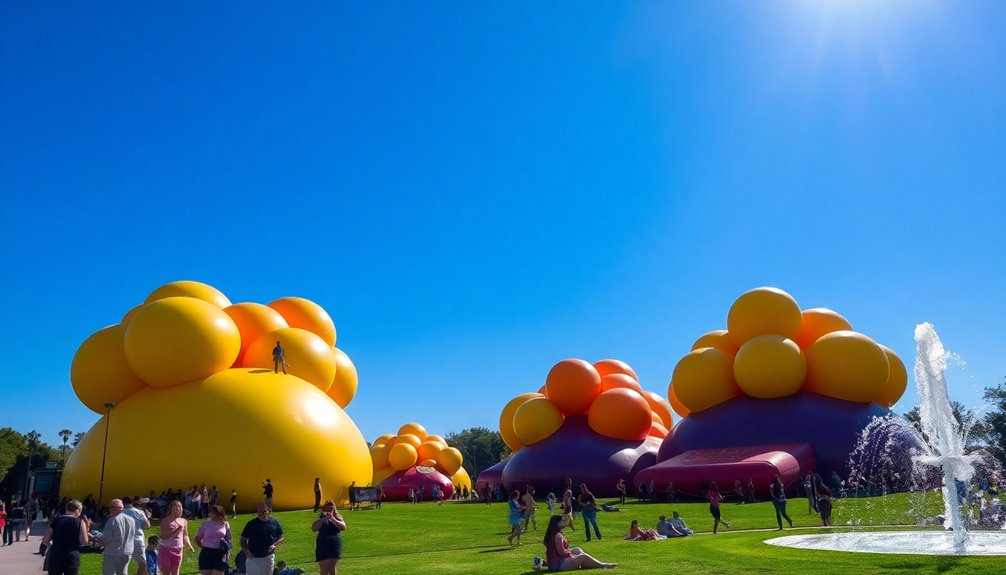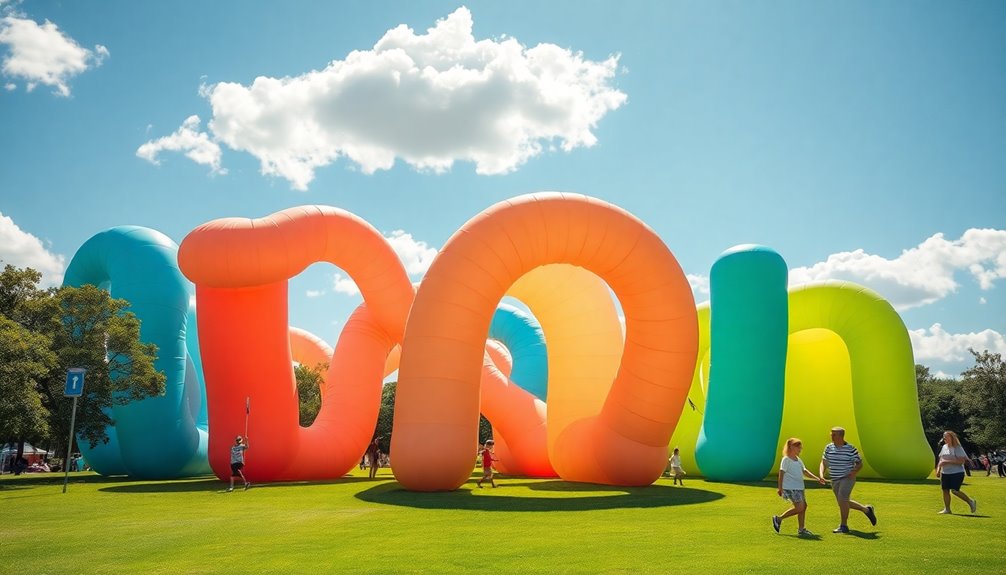Inflatable architectures are revolutionizing public spaces by creating playful, vibrant environments that invite interaction and foster community spirit. These structures pop up for events, turning urban areas into dynamic hubs for gatherings and exploration. They’re lightweight, colorful, and often made from sustainable materials, enhancing both joy and environmental responsibility. You’ll see how these designs spark new conversations about urban planning and creativity, paving the way for a more engaging future in city landscapes.
Key Takeaways
- Inflatable architectures transform public spaces by creating flexible environments for community gatherings and events, challenging traditional notions of permanence.
- These structures offer temporary and dynamic experiences, serving as pop-up parks, art installations, and performance venues that adapt to community needs.
- Their whimsical and playful designs foster social interaction and a sense of discovery, inviting exploration among visitors of all ages.
- Many inflatable architectures utilize sustainable materials and energy-efficient technologies, addressing urban sustainability concerns while balancing aesthetics and functionality.
- The future of urban planning will increasingly incorporate inflatable architectures, evolving into complex, interactive experiences that promote creativity and joy in public spaces.

As cities continue to evolve, you might find yourself intrigued by the rise of inflatable architectures in public spaces. These innovative structures have begun transforming your urban landscape, offering flexible and engaging environments for community gatherings, events, and leisure. You can’t help but notice how these designs challenge conventional ideas of permanence and functionality. Instead of rigid buildings, you’re now seeing playful, colorful inflatables that invite interaction and exploration.
Intrigued by the rise of inflatable architectures, you witness a transformation in urban landscapes, inviting interaction and redefining public spaces.
Inflatable architectures often pop up for temporary events or seasonal festivals, creating dynamic experiences that captivate your imagination. They’re not just visually appealing; they also serve practical purposes. You might see them used as pop-up parks, art installations, or even performance venues. This adaptability allows cities to respond to changing needs, whether it’s providing a space for community engagement or accommodating special events. You might find it exciting how these structures can be inflated in a matter of hours and deflated just as quickly, allowing for a fluid urban experience.
When you walk through these inflatable spaces, you’re likely to feel a sense of whimsy and playfulness. The materials used are often lightweight and bright, creating a cheerful atmosphere that encourages social interaction. You might even notice how children and adults alike are drawn to these structures, eager to touch and explore every nook and cranny. This sense of discovery fosters a communal spirit, reminding you of the importance of shared experiences in public spaces.
Moreover, inflatable architectures can also be environmentally friendly. Many of these designs utilize sustainable materials and energy-efficient technologies for inflation. You might appreciate how they embody a forward-thinking approach to urban design, addressing concerns about sustainability while still prioritizing aesthetics and function. As you consider the impact of climate change, these structures represent a step towards more responsible urban living.
As cities continue to embrace this trend, you can expect to see even more creative uses of inflatable architectures. They might evolve from simple structures into complex interactive experiences that redefine urban spaces. You’ll likely find it fascinating to witness how these ephemeral designs spark dialogue about art, community, and the future of urban planning.
In a world where change is constant, inflatable architectures remind you that adaptability and creativity can lead to vibrant, inclusive public spaces. So, the next time you encounter one of these delightful inflatables, take a moment to appreciate the innovation and joy they bring to your city.
Frequently Asked Questions
How Are Inflatable Structures Maintained Over Time?
Maintaining inflatable structures over time involves regular inspections and repairs.
You’ll need to check for leaks, wear, and damage frequently. Keeping the material clean prevents degradation, so a gentle wash can help.
Make sure you store them properly when not in use, ideally in a cool, dry place.
Additionally, using high-quality materials and following manufacturer guidelines will extend their lifespan, ensuring they remain safe and functional for all users.
What Materials Are Commonly Used in Inflatable Architectures?
When you’re exploring materials used in inflatable structures, you’ll find a variety of options.
Commonly, PVC and TPU are popular due to their durability and flexibility. These materials resist moisture and UV damage, making them ideal for outdoor use.
You might also come across reinforced fabrics, which offer added strength.
Additionally, some designs utilize air-filled chambers that can be made from lighter materials to reduce weight while maintaining structural integrity.
Can Inflatable Buildings Withstand Extreme Weather Conditions?
Yes, inflatable buildings can withstand extreme weather conditions, but their durability depends on materials and design.
You’ll find that high-quality, reinforced fabrics and proper anchoring systems are crucial. During storms, they can flex and adapt, reducing the risk of damage.
However, you should always consider local climate factors and ensure that the structure is designed with safety in mind.
Regular maintenance also plays a big role in their resilience against harsh elements.
Are Inflatable Architectures Eco-Friendly?
When you consider whether something’s eco-friendly, you’re looking at materials, energy use, and waste.
Inflatable architectures often use lightweight, recyclable materials, reducing the carbon footprint in production. They require less energy for transport and can be repurposed for different events.
However, their longevity and maintenance can impact their overall sustainability.
How Long Does It Take to Install an Inflatable Structure?
Installing an inflatable structure typically takes just a few hours, depending on its size and complexity.
You’ll start by preparing the site, ensuring it’s clear and free of sharp objects.
Then, you’ll inflate the structure using a blower, which usually takes around 15 to 30 minutes.
Once it’s inflated, you’ll secure it with weights or anchors to keep it stable.
Conclusion
In conclusion, inflatable architectures offer a unique and dynamic way to enhance public spaces. They create engaging environments that invite interaction and foster community connections. By embracing these innovative designs, you can transform ordinary areas into vibrant hubs of activity and creativity. So, whether you’re exploring a park or attending an event, keep an eye out for these fascinating structures. They not only captivate the eye but also encourage a sense of playfulness and participation in our shared spaces.










